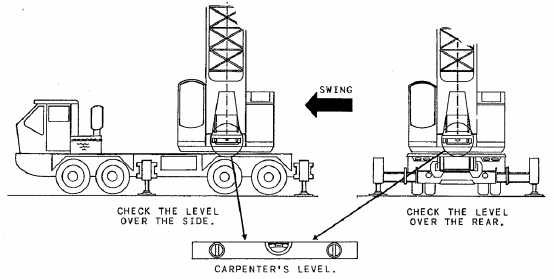cranes have levels mounted on them, but the
levels are not always accurate. Use a 3-foot
builder’s level to check the level of the crane over
the rear and over the sides (fig. 3-15).
After the test weights are figured, you must
remember that the hook blocks and rigging gear
are weight that are part of the test weight. The
maximum test weight for this example is set up at
the 15-foot radius measurement over the side of
the crane. Crane radius is the measurement from
the center of rotation to the center of the hook (fig.
3-16).
The crane is weight-tested with the boom
rotated ninety (90) degrees from the longitudinal
axis of the crane carrier. It is strongly
recommended by NAVFAC P-307 that precautions,
such as attaching guy wires to the mane or placing
cribbing under the counterweight, be used to
preclude possible overturning of the crane in the
event of wire rope or mechanical failure. Cribbing
is normally used in the NCF.
Before testing of the crane can proceed, the
crane test mechanic and the certifying officer must
be present at the test site. The crane test
mechanic and the crane test director will perform
and complete the BDA inspection during and after
the testing of the crane. This document must be
signed by the test mechanic and test director.
One purpose of weight testing the crane is
to check and make sure the hydraulic rams on
the outriggers support the crane and the
maximum lifted load. A way to check the
hydraulic rams is with a grease pencil and a
ruler. Measure from a known vertical point
on the hydraulic ram housing and place a line
with the grease pencil on the ram (fig. 3-17).
Figure 3-16.—Crane radius.
After
each
test,
measure
this
known
measurement, and this will enable you to make
sure there is no slippage in the hydraulic system.
5.4 No-Load Test
The first part of the crane test procedure is the
no-load test. The procedure is as follows:
Figure 3-15.—Builder’s level leveling procedures.
3-16




